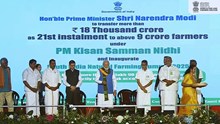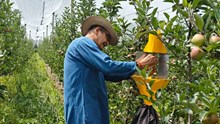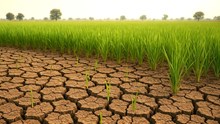
As the Kharif season begins, Indian agriculture comes alive with the arrival of the monsoon. Yet, this seasonal lifeline has grown increasingly unpredictable due to erratic rainfall patterns, rising water scarcity, and the broader impacts of climate change. In this evolving landscape, efficient irrigation practices are no longer optional—they are essential. Smart water management not only boosts crop productivity but also strengthens farmers’ resilience to climatic shocks.
Among the most promising solutions are innovative irrigation technologies that help optimize water use, particularly for water-intensive crops such as paddy, maize, cotton, and pulses. This article explores some of the most effective, research-backed irrigation techniques poised to revolutionize Kharif season farming.
Drip Irrigation and Fertigation
Drip irrigation involves the slow, precise application of water directly to the plant’s root zone through a network of valves, pipes, tubing, and emitters. This technique minimizes evaporation losses and ensures that water is used only where it is needed. It is especially effective for row crops, orchards, and vegetables. Fertigation, which is the application of fertilizers through drip irrigation systems, further enhances the efficiency of both water and nutrient use. This integrated approach ensures targeted delivery of nutrients, reducing wastage and improving crop yield and quality.
Drip systems also help reduce the growth of weeds between rows, since water does not spread to non-target areas. Crops such as cotton, maize, pulses, and vegetables have shown improved yields under this system when compared to conventional flood irrigation. Moreover, when used with mulching, drip irrigation maintains soil moisture for longer periods, increasing water-use efficiency.
Subsurface Drip Irrigation
Subsurface drip irrigation is an advanced form of the traditional drip method. In this technique, drip lines are buried beneath the soil surface, directly delivering water to the root zone. This reduces evaporation losses to almost zero and keeps the upper soil layer dry, further discouraging weed growth and reducing disease incidence. It is particularly beneficial in arid and semi-arid regions where water conservation is critical.
One of the key advantages of sub-surface systems is the uniform distribution of water and nutrients below the soil, promoting deeper root growth and enhancing plant stability and resilience. It also eliminates water stagnation on the field surface, making it suitable for crops sensitive to excess moisture.
Sprinkler Irrigation
Sprinkler irrigation simulates natural rainfall by distributing water through high-pressure sprinklers. This system is suitable for a variety of field crops, including maize, groundnut, and pulses, particularly in undulating or sandy terrains where other systems may be inefficient.
Sprinklers ensure uniform coverage, reduce soil erosion, and cool plant surfaces during hot spells, thereby improving plant health. With correct scheduling, this technique reduces water use significantly compared to flood irrigation.
Rainwater Harvesting and Farm Ponds
Rainwater harvesting is a time-tested practice that involves collecting and storing rainwater during the monsoon. Constructing farm ponds allows farmers to capture and store runoff water, which can be used for supplemental irrigation during dry spells.
By integrating farm ponds with gravity-fed drip or sprinkler systems, farmers can create self-reliant irrigation setups. This is especially useful in areas with erratic rainfall, ensuring water availability even in rain-deficit weeks of the Kharif season.
Mulching for Moisture Retention
Mulching is the practice of covering the soil surface with organic matter (like straw, leaves, or compost) or synthetic material. This reduces evaporation, moderates soil temperature, and suppresses weed growth. During the Kharif season, where intermittent rains are common, mulching helps conserve the moisture retained in the soil.
When combined with drip irrigation, mulching further improves water-use efficiency by keeping the soil moist for longer and protecting the soil structure from the impact of heavy rains.
Alternate Wetting and Drying for Paddy
Paddy cultivation is known for being water-intensive, yet research has shown that it is possible to grow rice with much less water using the Alternate Wetting and Drying (AWD) method. AWD involves periodically allowing the field to dry out before re-irrigating. This method can reduce water consumption by 30–40% without compromising yields.
AWD not only conserves water but also reduces methane emissions, making it an environmentally sustainable choice for paddy farmers. Simple field tools like perforated tubes or field markers can help monitor water levels to implement AWD efficiently.
Laser Land Leveling
Laser land levelling is a precision technique that levels the field using laser-guided equipment. A well-leveled field ensures even water distribution, reducing the time and quantity of irrigation required.
Studies show that laser levelling can improve water application efficiency by up to 50% while also enhancing fertilizer efficiency and crop uniformity. For Kharif crops like paddy, maize, and cotton, uniform fields help reduce waterlogging and optimize planting geometry.
Use of Drought-Resistant and Early-Maturing Varieties
While not a direct irrigation technique, the choice of crop varieties plays a key role in water use. Drought-tolerant and early-maturing varieties require less irrigation and are better suited for erratic monsoon patterns.
These varieties complete their life cycle in a shorter period, escaping terminal droughts and making the best use of available rainfall. Their adoption, coupled with efficient irrigation, results in both water savings and stable yields.
Controlled and Scheduled Irrigation
Using tools like soil moisture sensors or tensiometers, farmers can monitor the moisture status of their fields and irrigate only when necessary. This practice prevents both under- and over-irrigation, leading to better water productivity.
Scheduled irrigation based on crop growth stages ensures water is available when plants need it the most, during critical stages like flowering and grain filling. Such precision not only saves water but also improves yield quality.
Efficient irrigation is no longer an option but a necessity in today’s water-constrained agriculture. The adoption of techniques such as drip and sub-surface irrigation, fertigation, mulching, AWD, and rainwater harvesting can revolutionize Kharif season farming. These methods not only conserve water but also enhance productivity, reduce costs, and make farming more resilient to climate change. As government policies increasingly support micro-irrigation and climate-smart practices, the onus is on both policymakers and farmers to embrace these innovations and ensure a sustainable agricultural future.
















